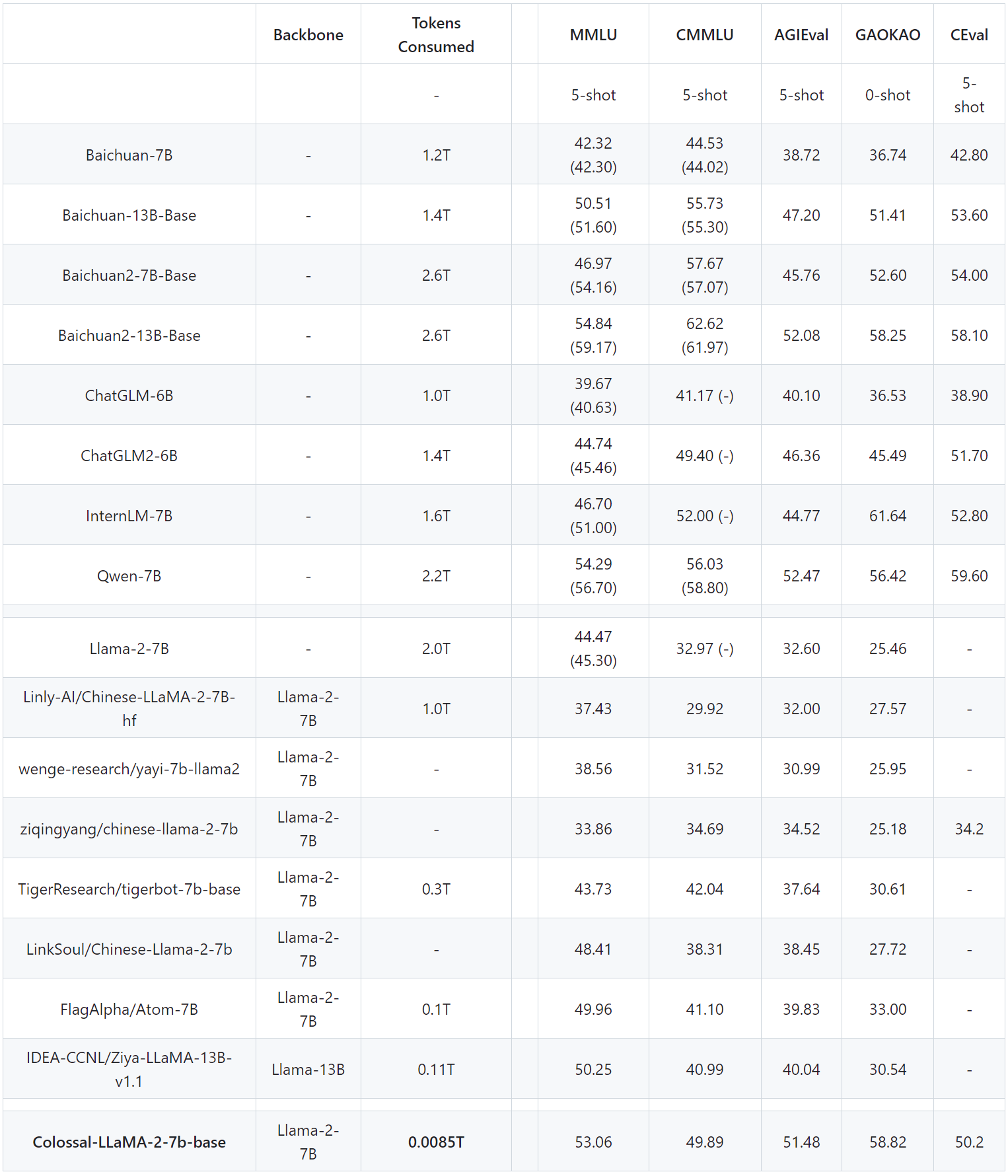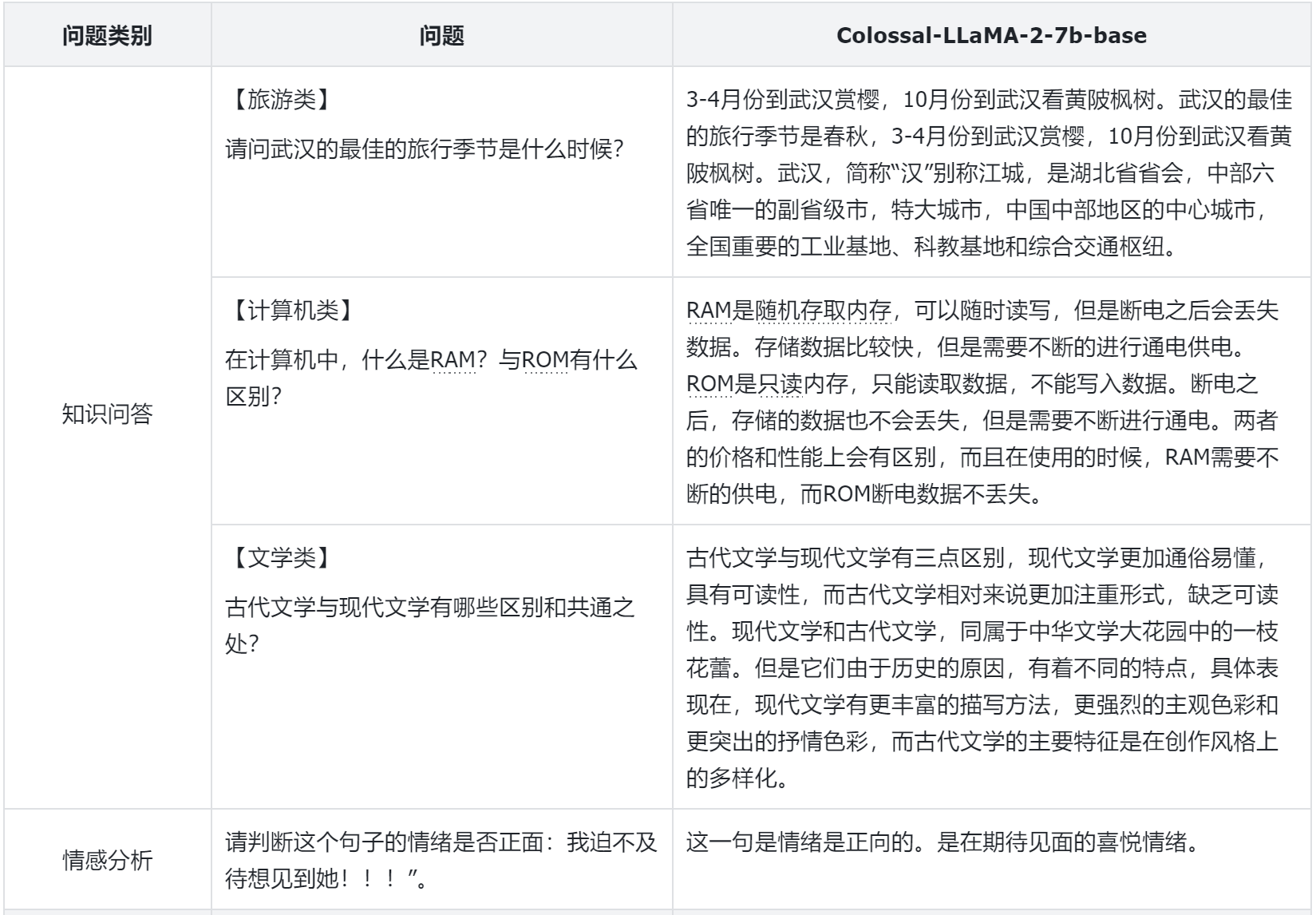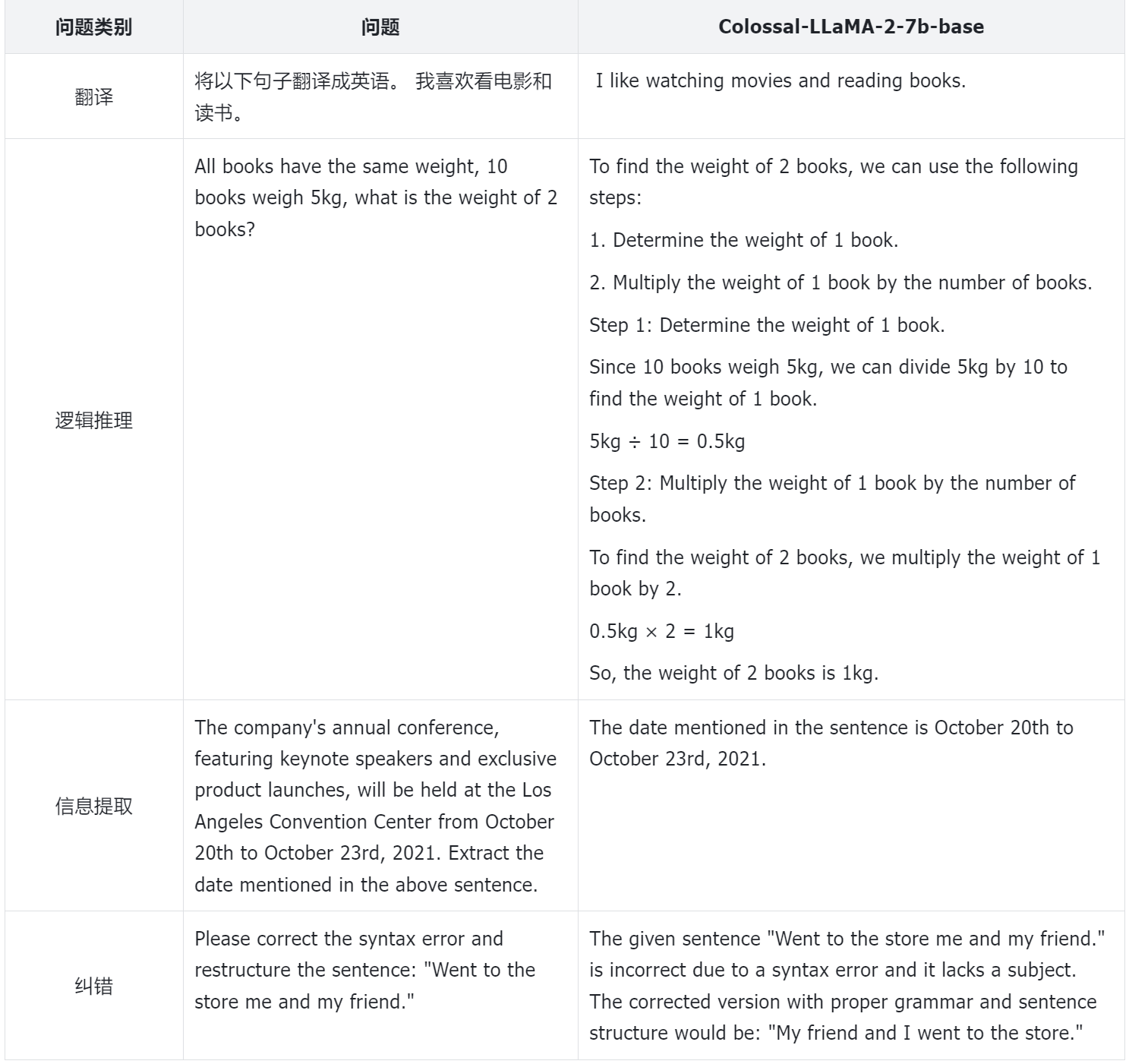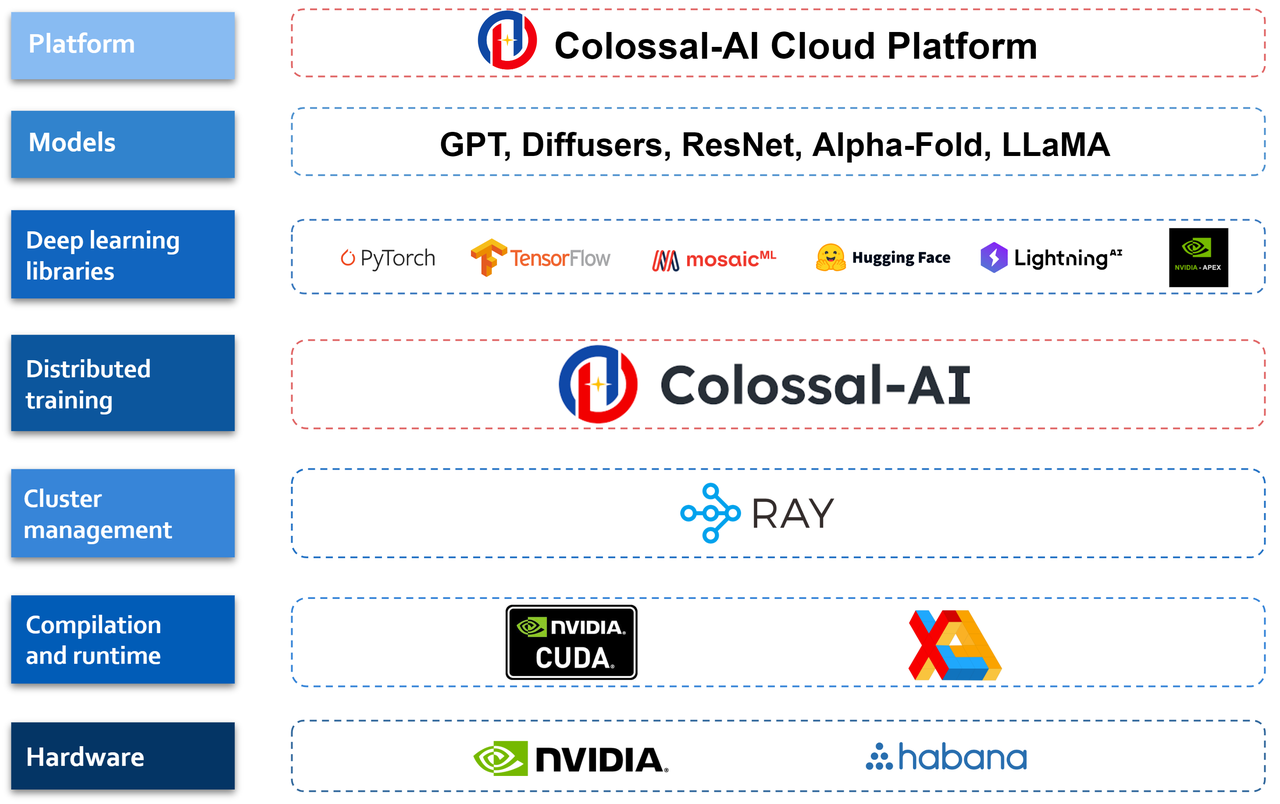One half-day of training using a few hundred dollars yields similar results to mainstream large models, open-source and commercial-free domain-specific LLM solution

The most prominent distinction between LLaMA-1 and LLaMA-2 lies in the incorporation of higher-quality corpora, a pivotal factor contributing to significant performance enhancements in LLaMA-2. This, coupled with its commercial availability, extends the potential for creative applications of large models within the open-source community.
Nevertheless, it's widely recognized that the cost of pre-training large models from scratch is exorbitant, often humorously referred to as a domain accessible only to those with "50 million dollars" to spare. This deters many companies and developers, so how can we build our own large models at a lower cost?
Being at the forefront of cost reduction and efficiency enhancement for large models, the Colossal-AI team maximizes the core capabilities of LLaMA-2. Through innovative training techniques, Colossal-AI has achieved remarkable results by utilizing only approximately 0.0085 trillion tokens of data, investing 15 hours, and incurring training costs in the range of a few hundred dollars. This strategy has yielded a high-performance Chinese LLaMA-2 model that consistently outperforms competitors across multiple evaluation benchmarks.
In contrast to the original LLaMA-2, Colossal-AI's model not only enhances Chinese language capabilities but also further refines its proficiency in English. Remarkably, it exhibits performance levels that rival state-of-the-art (SOTA) models of similar scale within the open-source community.
Underpinning Colossal-AI's approach are steadfast open-source principles. As a result, this model is made accessible without any commercial restrictions, with complete transparency extended to the entire training process, code, and model weights. In conjunction with this, Colossal-AI offers the comprehensive evaluation framework, ColossalEval, facilitating cost-effective reproducibility.
Moreover, the methodologies developed by Colossal-AI can be readily applied across various domains, facilitating the economical construction of large models that are pre-trained from scratch.
Open-source code and weights are available at :
https://github.com/hpcaitech/ColossalAI

Performance

Note: Based on ColossalEval scores, the scores in parentheses are from the official leaderboard scores of the corresponding models, and C-Eval scores are from the official Leaderboard.
In commonly observed English evaluation rankings, it can be observed that in the MMLU ranking, Colossal-LLaMA-2-7B-base, with the support of low-cost continual pre-training, has overcome the problem of catastrophic forgetting. Its capabilities have steadily improved (44.47 -> 53.06), showcasing outstanding performance among all 7B-scale models.
In the Chinese rankings, the primary comparisons were made against CMMLU, AGIEVAL, GAOKAO, and C-Eval. The performance of Colossal-LLaMA-2 significantly outshines other Chinese localization models based on LLaMA-2. Even when compared to other renowned models that employ Chinese language corpora and may cost millions of USD for training from scratch, Colossal-LLaMA-2 still stands out at the same scale. Notably, when compared to the original LLaMA-2, it has made a remarkable leap in Chinese language proficiency (CMMLU: 32.97 -> 49.89).
In addition, fine-tuning through methods like SFT and LoRA has limitations in effectively infusing knowledge and capabilities from the base model. It doesn't satisfactorily meet the requirements for constructing high-quality domain-specific knowledge or specialized model applications.
To better evaluate the performance of the models, the Colossal-AI team relies not only on quantitative indicators but also conducts manual evaluations on different model aspects. Below are some examples:


Looking at the entire training loss record, it's evident that while harnessing the cost-effective capabilities of the Colossal-AI system, the model's convergence is also well-preserved. With a training dataset of only about 8.5 billion tokens and computational costs in the range of hundreds of dollars, the model achieves such remarkable results. In contrast, many large-scale models available in the market require training with several trillion tokens to ensure effectiveness, incurring significantly higher costs.
 So, how did the Colossal-AI team manage to reduce training costs and achieve such impressive results?
So, how did the Colossal-AI team manage to reduce training costs and achieve such impressive results?
Vocabulary Expansion and Model Initialization
LLaMA-2's original vocabulary was not specifically optimized for Chinese and had a limited set of Chinese words, resulting in insufficient comprehension of Chinese language data. Consequently, the first step involved expanding the vocabulary of LLaMA-2.
The Colossal-AI team discovered that:
- Vocabulary expansion not only significantly improved the efficiency of encoding string sequences but also enriched the encoded sequences with more meaningful information. This, in turn, proved highly beneficial for document-level encoding and understanding.
- However, due to the limited volume of continual pre-training data, an extensive expansion of the vocabulary could result in certain words or combinations lacking practical meaning, making it challenging to learn them effectively from the continual pre-training dataset and impacting the final performance.
- An excessively large vocabulary would increase the number of embedding-related parameters, affecting training efficiency.
Therefore, after conducting numerous experiments while considering both training quality and efficiency, the Colossal-AI team decided to expand the vocabulary from the original 32,000 words in LLaMA-2 to 69,104.
With the expanded vocabulary in place, the next step involved initializing the embeddings based on the original LLaMA-2 for the new vocabulary. To facilitate a seamless transition of capabilities from the original LLaMA-2 to the Chinese LLaMA-2 while ensuring that the English proficiency remains unaffected in the initial state, the Colossal-AI team employed mean initialization of the new embeddings using the weights from the original LLaMA-2. This approach not only preserved the English language capabilities but also facilitated the smooth transfer of these capabilities to the Chinese language model.
Data Construction
To further reduce the cost of training, high-quality data plays a key role, especially for continual pre-training which has strict requirements for the quality and distribution of data. In order to better filter high-quality data, the Colossal-AI team has constructed a complete data cleaning system and toolkit for selecting higher quality data for continual pre-training.
The following image shows the complete data governance process of the Colossal-AI team:

In addition to conducting heuristic selection and deduplication of data, scoring and classification filtering were also applied to key data. Suitable data plays a crucial role in stimulating the Chinese capabilities of LLaMA-2, while simultaneously overcoming the catastrophic forgetting problem in English.
Finally, in order to improve training efficiency for data on the same topic, the Colossal-AI team sorted the data by length and concatenated it according to the maximum length of 4096.
Training Strategy
Multi-stage Training
In terms of training, given the characteristics of continual pre-training, the Colossal-AI team designed a multi-stage, hierarchical continual pre-training scheme, dividing the training process into three stages:
.png?width=1000&height=700&name=Colossal-ai%20llama2%20(4).png)
- Large-Scale Pre-training Stage: The goal at this stage is to enable the model to produce relatively smooth text through training with a large amount of corpus. This stage is completed by LLaMA-2. After this stage, the model has already mastered a large amount of English knowledge and can produce smooth results based on Next Token Prediction.
- Chinese Knowledge Injection Stage: This stage relies on high-quality Chinese knowledge. On one hand, it enhances the model's grasp of Chinese knowledge, and on the other hand, it improves the model's understanding of the newly added words in the Chinese vocabulary.
- Relevant Knowledge Replay Stage: This stage is dedicated to enhancing the model's understanding and generalization ability of knowledge and alleviating the catastrophic forgetting problem.
The multi-stage approach complements each other, ultimately ensuring that the model progresses equally in both Chinese and English abilities.
Bucket Training
Continual pre-training is extremely sensitive to data distribution, so balance is particularly important. To ensure a balanced distribution of data, the Colossal-AI team designed a data bucketing strategy, dividing the same type of data into 10 different bins. During the training process, each data bucket contains one bin of each type of data, thereby ensuring that each type of data can be utilized evenly by the model.
Evaluation System
To better assess the performance of the model, the Colossal-AI team has built a complete evaluation system - ColossalEval, which evaluates large language models from multiple dimensions. The framework and code of the process are fully open-source, supporting the reproduction of results and also allowing users to customize datasets and evaluation methods according to the application scenario. The characteristics of the evaluation framework are summarized as follows:
- It includes common datasets for evaluating knowledge reserve capability of large language models, such as MMLU, CMMLU, etc. For formats like multiple-choice questions and comparing probabilities of ABCD, more comprehensive calculation methods are added, such as absolute matching, single-choice perplexity, etc. This aims to measure the model's grasp of knowledge more thoroughly.
- Support evaluation for multiple-choice questions and long-text assessments.
- Support evaluation methods for different application scenarios including multi-turn dialogues, role-playing, information extraction, content generation, etc. Users can selectively assess different aspects of the model's abilities based on their specific needs. Additionally, the system supports the extension of custom prompts and evaluation methods to cater to individual preferences and requirements.
Bridging from General Large Models to Domain-specific Large Models
From the experience of the Colossal-AI team, constructing a Chinese version of LLaMA-2 can be summarized into the following process:

So, can this process be reused?
The answer is affirmative, and it holds great significance in real-world implementation scenarios.
As the wave of artificial intelligence driven by ChatGPT surges, major internet giants, AI companies, startups, universities, research institutions, and others are all actively participating in the race of large general-purpose models. However, behind the generality of these large models often lies a lack of domain-specific knowledge. Consequently, the issue of practical applicability becomes particularly serious. While fine-tuning for specific applications can yield some benefits, the absence of domain-specific large models creates performance bottlenecks in application deployment.
If a domain-specific large model can be rapidly and cost-effectively constructed, followed by fine-tuning for specific business needs, it would undoubtedly advance the deployment of applications, providing a competitive advantage.
Applying the above process to perform knowledge transfer in any field allows for the cost-effective construction of lightweight domain-specific foundational large models:

For constructing foundational large models from scratch, one can also draw inspiration from the aforementioned experiences and Colossal-AI's cost-reduction and efficiency-enhancing capabilities to efficiently achieve this goal at minimal cost.
System Optimization
The impressive performance and cost advantages of Colossal-LLaMA-2 are built upon the foundation of the low-cost AI large model development system, Colossal-AI.
Colossal-AI, based on PyTorch, leverages efficient multi-dimensional parallelism, heterogeneous memory, and other techniques to reduce the development and deployment costs of AI large model training, fine-tuning, and inference. It enhances model task performance, reduces GPU requirements, and more. In just over a year, it has garnered over 30,000 GitHub stars within the open-source community. It ranks first in the world in the field of large model development tools and communities and has collaborated with numerous Fortune 500 companies and other well-known enterprises to develop/optimize models with hundreds of billions or tens of billions of parameters and create domain-specific models.
Colossal-AI Cloud Platform
To further enhance the efficiency of large model development and deployment, Colossal-AI has been upgraded to the Colossal-AI cloud platform. This platform allows users to train, fine-tune, and deploy large models at a low cost on the cloud through low-code/no-code methods while quickly integrating models for personalized applications.

Currently, the Colossal-AI cloud platform has pre-installed mainstream models and solutions including Stable diffusion and LLaMA-2. Users only need to upload their own data for fine-tuning, and can deploy their fine-tuned models as APIs.
Users can utilize GPU resources like A10, A100, H100, etc at affordable prices, without maintaining computational clusters and various infrastructures. More application scenarios, various fields, different versions of models, and enterprise private platform deployments are continuously being iterated.
The ColossalAI cloud platform is now in public beta, and registration will provide you with vouchers. We welcome participation and feedback.
Colossal-AI Cloud Platform: platform.colossalai.com
Colossal-AI Open Source Address: https://github.com/hpcaitech/ColossalAI
Comments